"One of the most tragic things I know about human nature is that all of us tend to put off living. We are all dreaming of some magical rose garden over the horizon instead of enjoying the roses that are blooming outside our windows today." -Dale Carnegie
Our new Ask Ethan segment has been really popular, and the questions and suggestions keep pouring in. It's your Universe too, and if there's something you want to know about it, you should ask! (So keep it up!) This week's question is one of the biggest of them all, and it comes courtesy of John L. Ferri, who asks,
I have a difficult time understanding cosmic inflation and the horizon problem. I think you covered it once before, but more detail may help my confusion.
Let's back up to the beginning, to put this in some context.
This is your Universe. It goes on as far as the most powerful telescopes ever devised can see in all directions, finding tens of thousands of galaxies located tens of billions of light years away everywhere we've ever looked. On the largest scales, it's roughly the same -- the same densities, temperatures, star-and-galaxy types, metallicities, etc. -- no matter where we attempt to look. The biggest difference we've found is that the farther away we look, the younger the things we're looking at appear to be, and the faster they appear to be receding from us.
This has to do with how the Universe is expanding and evolving. Thanks to three big pieces of evidence in the context of General Relativity (our theory of gravity):
- The Hubble expansion of the Universe, or the observation that a galaxy's apparent redshift correlates with its apparent distance from us,
- The existence and properties of the Cosmic Microwave Background (CMB), or an almost-perfectly-uniform sea of blackbody radiation in all directions just a few degrees above absolute zero, and
- The abundances of the light elements -- hydrogen, deuterium, helium (He-3 and He-4) and lithium -- in the earliest recesses of the Universe, before any stars had formed,
we can safely conclude that the Universe evolved and expanded from a hotter, denser state, and that has been around in its current matter-and-radiation-filled form for about 13.8 billion years. A long time, but not an infinite amount of time. This paradigm is known colloquially as the Big Bang.
But there's an issue here. Over the past 13.8 billion years, the Universe has expanded according to the rules of General Relativity, which means the rate that space has expanded is determined by some set of initial conditions and also on the energy content (normal matter, dark matter, radiation, neutrinos, dark energy, spatial curvature, etc.) of the entire Universe. That part is fine, but the issue is that the Universe appears to have the same rough, average properties everywhere we look.
The densities and clustering properties of galaxies on one side of the Universe are identical to those observables on the other side, no matter what arbitrary "side" you choose. This should strike you as weird. Why?
Consider that since the Big Bang, no information has been able to travel faster than the speed of light. We can "see" 46 billion light years in each direction because that's how far light has been able to travel in the expanding Universe over the past 13.8 billion years. So if we can look more than 23 billion light years in one direction and more than 23 billion light years in the other direction, we wouldn't expect these regions to be related.
Still confused? Let's give you an analogy to help understand this better.
 Image credit: Crystal of http://crystalandcomp.com/.
Image credit: Crystal of http://crystalandcomp.com/.
Consider boiling water in a pot on your stove. You heat the water from the bottom, and -- as best as you can tell -- the water boils at the same time everywhere in the pot. There's no discernible temperature difference between the top of the water and the bottom. Think about that fact for a second.
Why is that?
You're heating the pot of water from the bottom, but the water is heating up everywhere. This is because the water molecules are moving around, bumping into other water molecules, and sharing their energy among one another. You may be heating the water from the bottom, but the water from the bottom can interact -- and exchange information/energy -- with the water in the rest of the pot, and can do it on timescales that are very small compared to the timescale of heating the water to a boil.
This isn't always the case.
Consider the above photo, where lava flows down from an active volcano and into the ocean. Where the lava -- well over 1,000 °C -- strikes the water, it boils almost immediately due to the incredible temperature difference. But the ocean is vast, and the rate of heat transfer is finite; you don't have to go very far away from where the lava enters the water at all to find waters where the temperature is virtually unaffected by the lava heating the water. For all practical purposes, those regions are causally disconnected from one another, because they do not exchange information or share properties with one another.
It would be very surprising if causally disconnected regions -- regions that didn't come in contact with one another or exchange information with one another -- had the same temperatures. Yet that's exactly what the Universe appears to do!
Consider that the Cosmic Microwave Background (CMB) was emitted when the Universe was just 380,000 years old, and that in that time -- even in our rapidly expanding Universe -- light could have only traveled around one million light years in any direction. If you filled in the microwave sky with circles a million light-years in radius, it would take more than ten billion independent regions to fill what we can see! And yet, these causally disconnected regions have the same temperatures, spectra, and densities to about 99.99% precision.
That problem -- that regions that have never had a chance to exchange information with one another just happen to have identical properties to one another -- is known as the horizon problem.
But there is a way to solve it; these regions may not have had time to exchange information with one another since the Big Bang, but what if the Big Bang began with them already having the same properties?
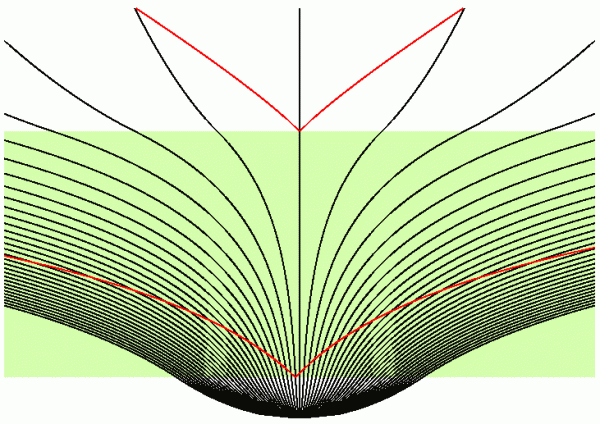 Image credit: Ned Wright, via http://www.astro.ucla.edu/~wright/cosmo_04.htm.
Image credit: Ned Wright, via http://www.astro.ucla.edu/~wright/cosmo_04.htm.
In a nutshell, that's what inflation is: the thing that happened before the Big Bang that not only sets it up, it sets up the initial conditions that our Universe appears to have! By taking a small, tiny region (possibly even an infinitesimal region) and expanding it exponentially, that tiny region stretches to a size larger than our presently observable Universe, and ensures the following:
- That any matter, particles, energy or topological defects existing in that region of space prior to inflation will be so reduced in density that -- at most -- there will be only one such particle left in our Universe (solves the monopole problem),
- Whatever curvature space had prior to inflation, inflation stretches it so that it will appear to be indistinguishable from flat when we look at it post-inflation (solves the flatness problem),
- Whatever variations there were in temperature or density across different regions of space prior to inflation, it's only one tiny region that gave rise to our entire observable Universe, explaining why our Universe appears to have the same temperature-and-density properties everywhere we look (solves the horizon problem), and
- Quantum fluctuations that take place (according to well-understood laws) during inflation give rise to a very particular set of predictions for temperature-and-density fluctuations (and imperfections) in our observable Universe today. (Some more explanations here, here and here.)
Item number three is how the horizon problem is solved: by taking a tiny region where things once were connected and stretching it to such a large size that everything we see -- although they're not connected since the Big Bang -- was once connected before the Big Bang.
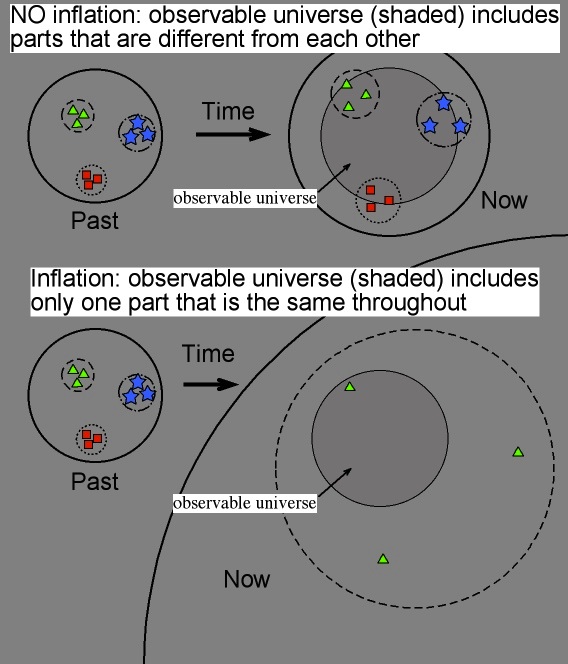 Image credit: horizon problem via http://astronomynotes.com/.
Image credit: horizon problem via http://astronomynotes.com/.
If you don't allow inflation, then you simply have to sweep those three problems (monopole, flatness and horizon) and one prediction (about the now-confirmed spectrum of density-and-temperature fluctuations in the Universe) under the rug, and say, "Those are just the initial conditions the Big Bang started with" to make your model work.
Or, you can embrace inflation as the simple, elegant and straightforward way to solve all of them.
And that's why the Universe -- to the best of our knowledge -- is the same everywhere and in all directions.
Have a question or suggestion? Drop me a line in our question/suggestion box, and your idea could get the Ask Ethan treatment next!
- Log in to post comments

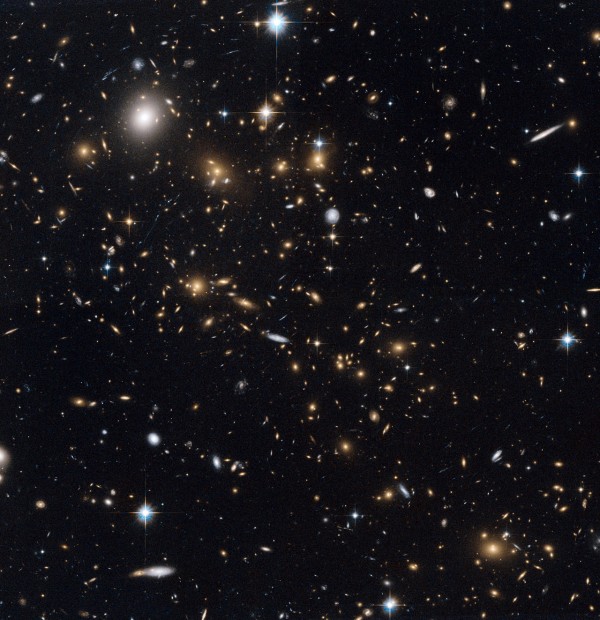
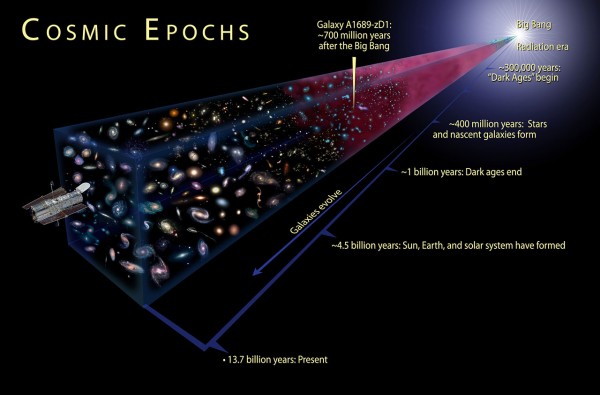
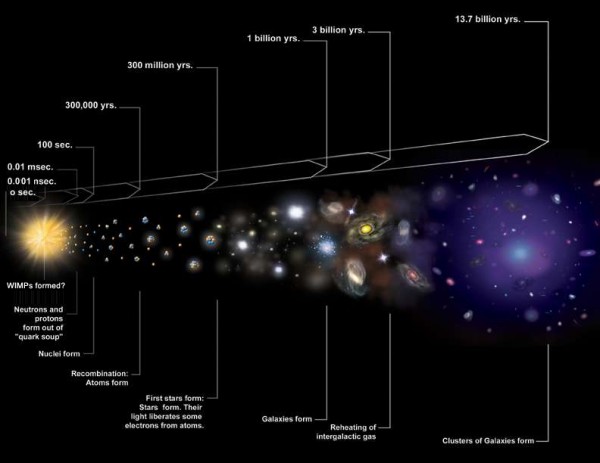
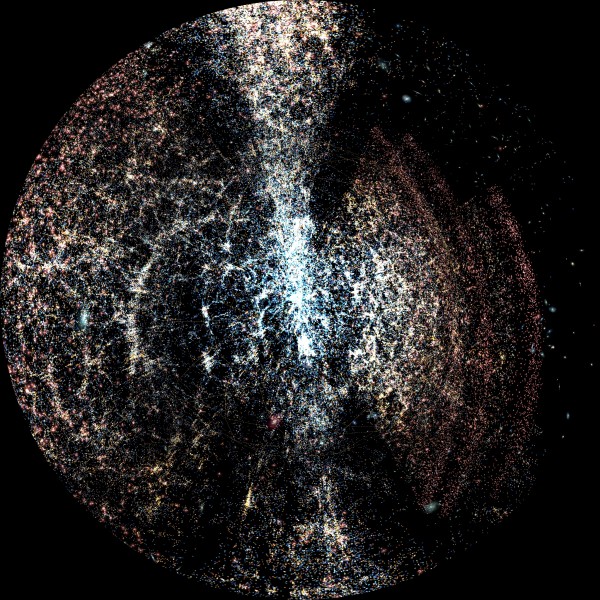

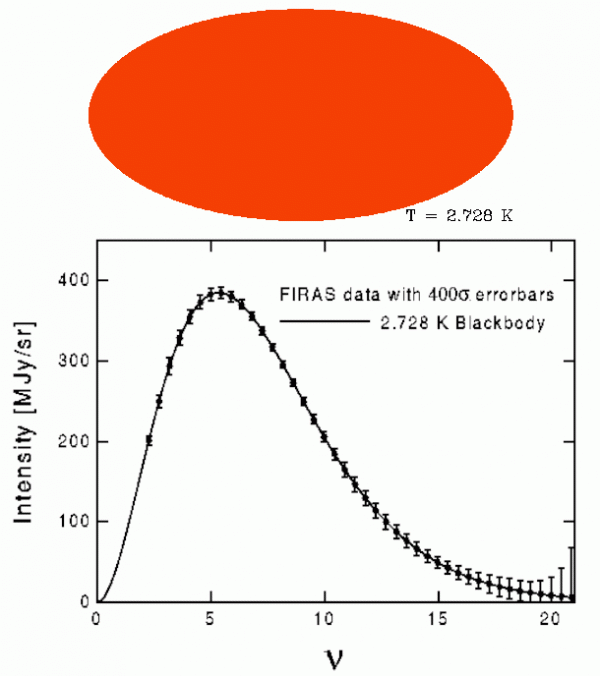
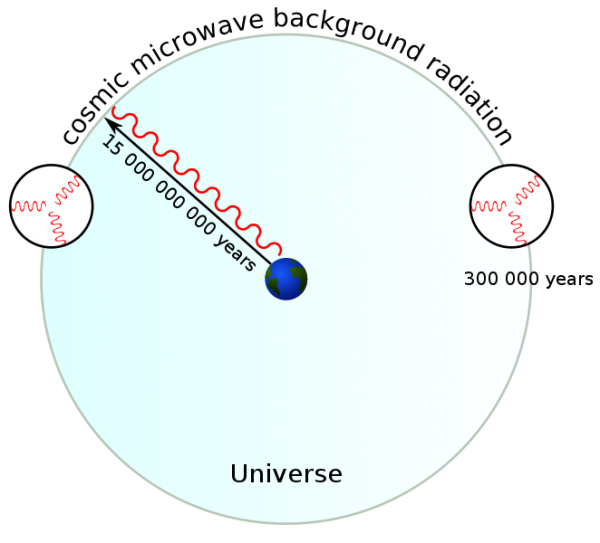
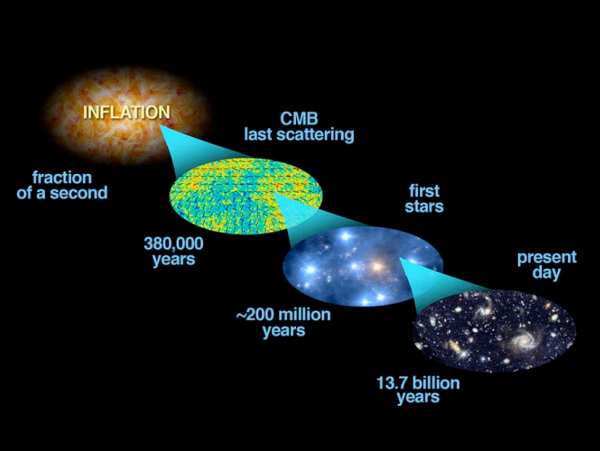
Interesting - that does help. One terminology question: what would be "topological defects" (as referenced in the first of the four points)?
Is the assumption then that the universe didn't start in a singularity? A zero-dimensional point is trivially the same everywhere.
Easy to read. Damn near impossible to understand or comprehend
This is a good article, but I take exception to the following statement:
"that’s what inflation is: the thing that happened before the Big Bang"
I read your previous articles, and not a single cosmologist I know defines inflation and the Big Bang the way you do (and being an experimental cosmologist myself, I know quite a few).
Rather, they say inflation did not happen before the Big Bang, since the "Big Bang" is simply t = 0 (where t=380,000yr is recombination and t = 13.7Gyr is now). Rather, inflation happened immediately after the Big Bang, and the process was over by t ~= 10^-34 second.
Inflation generates the initial conditions of the early universe's subsequent evolution without having to have a fine-tuned initial state at the Big Bang itself.
To answer dean: "topological defects" are things like monopoles (0-dimensional), cosmic strings (1-dimensional), and domain walls (2-dimensional) that have different physical properties than the 'regular' universe.
One thing I'm still missing from this is the assumption that causally disconnected regions should have different properties in the first place. The coloured triangles, stars and squares in the second-last figure. I'm sure there's a solid quantum mechanical reason for this but to the classical mind it seems that if they had undergone the same pre-inflation history they would be the same regardless of whether they had been connected. The seawater example doesn't really help because if you think of the synthesis of two tubs of seawater via an identical process you would expect them to end up identical.
There's a brain-bender you casually mentiuon with no attempt to explain it Ethan. You say;
Am I missing something here? Is this a typo? How does light travel 46 bly in only 13.8 by?
*mention*
http://scienceblogs.com/startswithabang/files/2013/11/heic0805c-600x395…
There is an error in that picture. The ~4.5 Billion should read 9.2 Billion years. This will confuse many people. While the earth was created 4.5 billion years ago, the rest of that picture tells how long ago the universe was created.
I still don't understand why disconnected parts of the universe aren't the same just because they were created at the same time in the same explosion.
@mike#9: The diagram is right. It shows the time elapsed SINCE the Big Bang. So 4.5 billion ly = 9.2 billion ago.
@Artor #7: Not a typo. It's because of the expansion of space.
Obviously light can't travel faster than light; rather, the place from which the light was emitted is now much further away from us than it was originally.
Ethan has actally posted about this before: http://scienceblogs.com/startswithabang/2013/03/01/how-big-is-our-obser…
@ 2 Ben
Singularity is not in picture. Notice that inflation requires spacetime to exist and it requires a field (inflation field) in order to work. Those already existed. Thus inflation doesn't give an answer how spacetime came to be. No theory does so far.
@6 John
Disconnected regions needn't have different properties per say. But they can. That's the issue. In current time all have same properties. How?
If we stick to energy and temperature, of course it's possible for two causally unlinked places to have same temperature. It's called chance or coincidence. But it's impossible for all of them to have same temperature and not be linked by some physical process. Because the chance to have same properties and not be linked is same as having different properties and not be linked. If it's random.
So why don't we have regions that are i.e. 7 or 10K. By chance, it should happen. But it doesn't. Conclusion being that thermal equilibrium was achieved before inflation. That region we occupy now was in near perfect thermal equilibrium before it got inflated. That's why everything within our inflated bubble is same now.
@ 10 Keith
no, no explosion, no "creation" of parts of universe. Nothing like that. You don't have the right mental picture of Big Bang.
p.s.
@2 Ben
singularity doesn't work for other reasons as well, but those have nothing to do with inflation.
The simplest... if you have something that is infinite.. a singularity. You need an infinite amount of something else to make that first infinity anything else than infinity.
Yes, you can say the Universe started with a singularity. But why isn't it still a singularity? Once physicists started to tackle that issue, it was soon realized that singularities just don't work.
They don't work for black holes either, Sinisa.
I think Ethan describes inflation fairly well here, albeit with a minor issue of what came first. But I have to say that inflation as described doesn't actually explain anything. You could equally assert that the available evidence suggests that the early universe was flat and homogeneous.
Mind you, I think there was a form of inflation, but a little different to the usual description, one involving GR time dilation. Imagine the early universe expanded at some slow steady pace, like a pumpkin. If you were in that universe, you would be subject to something akin to the infinite time dilation at a black-hole event horizon. So you would claim that the slow steady pace was extremely rapid, as would observers at a later epoch.
@ John
your view is left stuck with monopoles. Probably some other things as well, but this is the obvious one to me. From energy scales of early universe, you would expect to find monopoles. The fact we don't makes your model fail.
@ John
p.s.
another obvious thing would be CMB. No time dilation or anything of sort would produce CMB patterns.
Many comments; let's see what I can do.
dean @1, a topological defect is anything that, if you removed all the matter and energy in the Universe, would still leave spacetime deformed. The simplest is to imagine a knot in spacetime (a 0-dimensional defect); magnetic monopoles would be such an example of this. But you can also have 1-d defects (cosmic strings, that would cause a linear discontinuity in the Universe), 2-d defects (domain walls, that would cause a planar discontinuity), 3-d defects (cosmic textures), etc. There have been extensive searches for these defects, both experimentally and observationally, and -- with one famous exception -- there are only constraints.
Benhead @2, the temperature fluctuations in the CMB constrain the energies the post-inflationary Universe to be at most a factor of ~1000 lower than the Planck scale, so there's no way to have an effectively zero-dimensional point there. Inflation, because of its exponential nature, is past-timelike-incomplete, which only means that it never starts from a true single (zero-dimensional) point. (See this older post.) But there could have been a pre-inflationary state that spawned our inflating Universe; the Bunch-Davies vacuum is an excellent candidate for that, although I'll point out that this discussion is very speculative, based on unobservables and experiments beyond the scope of our Universe.
asad @5, are all the cosmologists you know incredibly old? I ask that because identifying t=0 as "the moment of the Big Bang" is a relic from pre-inflationary Big Bang cosmology, and considering that inflation came out over 30 years ago, it's an odd thing to continue teaching. The facts are that the Big Bang -- or as it was called by its non-detractors, the primeval fireball -- was assumed to have begun in a singularity because that's the natural extension of a matter-and-radiation-dominated Universe in a FLRW cosmology. But if there's an inflationary state preceding the matter/radiation-filled Universe, then you don't know how long inflation went on for (you only have a lower limit), and the t=0 time ceases to have any importance. (See this long post for a further explanation.) I get where the "The Big Bang is t=0" comes from, but it's a historical relic that should be consigned to the rubbish bin of history in the light of the inflationary paradigm.
John @6, I had that exact same objection when I was an undergrad, figuring something like: hey, if it's the same Universe at the same starting point, why shouldn't it have the same properties everywhere? And what I didn't realize is that my inherent assumption was that there was a point in the past that there was something that could be construed as a starting point, with the same properties everywhere, something that can never be technically true in a matter-and-radiation-dominated Universe in an FLRW cosmology. It might violate our intuition about thermodynamics, but our intuition is wrong, and the level of homogeneity in the Universe's temperature is something we simply have to insert a priori and say "the Universe began with these initial conditions," or we could look for dynamics (like inflation) that demand them. The latter is how science advances.
Artor @7, darkgently @12 has recommended exactly the article I would have recommended to you: this one. Imagine an ant crawling between two points along the surface of a balloon as the balloon is blown up. The ant may herself walk 13.8 cm, but then look back at her initial departure point and find that it's 46 cm away. That's what the Universe is like.
mike @9, I had never noticed that mistake on the STScI image; you're right! I'll have to either make some crude edits next time or find a different image. Also, there are other numerical mistakes on that image (~300,000 should be ~380,000), so the image is only qualitatively interesting.
John @15, you have to remember that inflation makes predictions about the initial spectrum of density and temperature fluctuations in the Universe, predictions that were uncovered in the 1970s and 1980s by Starobinskii, Bruce Allen and others. They predict, among other things, an almost perfectly scale-invariant spectrum of density (scalar) fluctuations but with a slight red tilt to them, a set of tensor fluctuations that generally adheres to only two sets of predictions (either "new inflation" or "chaotic inflation" styles), and that these observations from the recent CMB experiments have matched these predictions. To contend that "inflation as described doesn’t actually explain anything" is grossly unfair. As Sinisa alludes to, you'd also have to remove any high-energy relics from the Universe, although it's conceivable that ultra-high-energy physics is such that none exists; a far greater "dealbreaker" problem is the CMB, which cannot be explained without inflation or, alternatively, something very much indistinguishable from it.
Remember, if you've got a question that you think is good enough for an entire column, just send it over in the question/suggestion box!
Ethan,
Thanks for the explanation. It should make Guth's "The Inflationary Universe" a little more understandable to me.
JLF
Like the story of the ten blind men describing an elephant? Also: same, human senses used to detect? Also: Same time-frame. Also: same historic perspective. Wouldn't it be3 strange if none concurred?
@mike#9, @ethan#18: Ignore if you can my #11 comment, which is "not even wrong." I blame the wine.
@Ethan re #18: I did say that I think there was a form of inflation. But I will reiterate that the “given explanation” for inflation doesn’t really explain the horizon problem, the flatness problem, or the monopole problem. Your explanation here is pretty good in that it adheres to the given explanation, which at first glance appears to offer an explanation of sorts. But look closely and it’s a turtles all the way down non-explanation wherein inhomogeneity/curvature is smoothed/airbrushed away by a magic inflation that in itself is not explained. I’m not being unfair about that, I’m being blunt. I think reconciling inflation with general relativity is the way to fix this, along with an issue in FLRW cosmology. What I do think is the right approach is to liken the universe to a black hole, but there’s problems with the “given explanation” there too. By the way I think the monopole problem comes from a misinterpretation of Maxwell. An electron doesn’t have an electric field, it has an electromagnetic field.
@John Duffield #22: Does your favourite form of inflation make the same (correct) predictions about the CMB spectrum? Inflation has real explanatory power because it makes testable predictions. You seem to have ignored that.
And "reconciling inflation with general relativity"... that's new to me. How exactly are they in conflict?
Finally, your statement about EM is confused. The electric field E is a perfectly valid entity, as is the magnetic field B. Maxwell's tensor F has 6 independent components (because of antisymmetry) which are the three spatial components of E and B (in the appropriate order). There's nothing wrong, mathematically or physically, with talking about them in isolation.
Until we learn why and how gravity works these theories are all that we have. That may be a long time though.
John @22:
Ethan didn't include a mechanism for inflation in his post, but there is one: a negative vacuum energy density. AFAIK its an hypothesis at this point. Still needs to be tested some way. However, other posters have already pointed out to you how the standard inflationary hypothesis and mechanism has two huge advantages over your preferred hypothesis. First, its one mechanism and effect that can explain a multitude of seemingly independent observations. Secondly, it is consistent with all our observations - yours isn't.
I'm reminded of a previous article by Ethan, about a *serious* attempt to find another way to explain the CMB, using black holes. They did manage to do a good job of matching the temperature, but couldn't get anywhere close to the intensity at the same time. And that's just the basic shape of the CMB, not even dealing with explaining the spectrum of fluctuations like inflationary models!
Still, it was good science. Because it was fundamentally based on trying to explain the evidence. Rather than declaring that the mainstream theory has no explanation (because they didn't bother to look to see if there was one) and then not worrying about evidence.
P.S. No, theorists working on theories with magnetic monopoles did not "misinterpret" Maxwell. You did, as demonstrated when you said induction in wires was "a trace of imbalanced forces". Har har har!
Test. please ignore.
Excellent!
Glad it's working!
I know the servers have been wonky for some time now, I've seen issues too. We are finally going to upgrade them on Wednesday (Nov. 20th), so please don't try to write any comments that day until late in the evening (assuming everything goes well).
I'll make a more general announcement at the end of Messier Monday next week.
Darkgently: I didn’t say anything about CMB spectrum predictions because as far as I know they predate the “inflaton”, see precusors in the wiki article. There’s a reference to GR there. There’s a conflict because time dilation doesn’t feature in inflation as usually described. I’m not confused about electromagnetism. The field concerned is the electromagnetic field. An electron has an electromagnetic field. E and B denote linear and rotational force resulting from electromagnetic field interactions. Look at Minkowski’s Space and Time and note this:
"In the description of the field caused by the electron itself, then it will appear that the division of the field into electric and magnetic forces is a relative one with respect to the time-axis assumed; the two forces considered together can most vividly be described by a certain analogy to the force-screw in mechanics; the analogy is, however, imperfect."
CB: theorists who proposes magnetic monopoles don’t understand electromagnetism. It’s that simple. See above. The electron has an electromagnetic field.
Eric: a negative vacuum energy density is wrong. Sorry. The energy density of space is positive, and always has been. And I’m afraid the “standard” inflationary hypothesis doesn’t actually explain anything. It just sweeps it under the carpet. Try explaining it for yourself and you’ll soon spot this.
John: your link is broken. But the inflationary predictions I was referring to in the CMB include a small primordial tilt in the power spectrum, which was recently confirmed by Planck.
You'll have to explain your supposed conflict in detail. Inflation uses GR which automatically incorporates time dilation so I have no idea what you're referring to.
I'm afraid you're still confused about EM. Your quote simply refers to the fact that the E and B components get "mixed up" under certain coordinate transformations. This is well understood. If you're going to use this to assert that the electron doesn't have an electric field, then you might as well also assert that the earth doesn't have a magnetic field, and compass makers are just misunderstanding Maxwell. ;)
In any case, contrary to your claim, this has nothing whatsoever to do with monopoles. Their (predicted) absence comes from the fact that the integral of the Maxwell tensor over any closed surface vanishes, which is obviously coordinate-independent.
"...a negative vacuum energy density is wrong. Sorry." And you know this how? Divine revelation?
"CB: theorists who proposes magnetic monopoles don’t understand electromagnetism. It’s that simple. See above. The electron has an electromagnetic field. poses magnetic monopoles don’t understand electromagnetism. It’s that simple. See above. The electron has an electromagnetic field. "
Ha! So would magnetic monopoles. They would simply couple to it in a slightly different, highly symmetric, and well-defined way.
Try actually studying Maxwell's equations, instead of a vague summary. When you can understand why the right hand side of Gauss' Law is an empirical observation not a required or even natural feature of the theory, and what it would imply if it were ever measured different, you'll be able to enter the conversation.
I could try explaining it, if you'd like. But a hundred years of physicists who understood Maxwell's equations, including those who successfully extended them into even more accurate descriptions of reality, understand that it allows for monopoles, even if they are working on theories that don't include them.
Instead you just learn one thing, that electricity and magnetism are really aspects of the same thing thing, and then run off from there as if that's all there was to learn on the subject and the rest can be extrapolated from that and your imagination.